Yesterday Nvidia lifted the embargo on the MSRP-priced RTX 4060 cards ahead of the RTX 4060 hitting the store today. Now that it is available in stores we can now also talk about the other models as well. ZOTAC GAMING sent over their RTX 4060 Twin Edge OC White Edition which is similar to the Twin Edge White Edition of the RTX 3060 that I previously took a look at. Today I’m going to dive in and see what ZOTAC GAMING has going on with their new card then put it through our test suite to see how it performs.
Product Name: ZOTAC GAMING RTX 4060 Twin Edge OC White Edition
Review Sample Provided by: ZOTAC GAMING
Written by: Wes Compton
Amazon Affiliate Link: HERE
What is the RTX 4060
If you took a look at last month's RTX 4060 Ti launch, you would know a lot about the RTX already. Both GPUs are based on Ada Lovelace but the RTX 4060 Ti is based on the AD106 GPU whereas the RTX 4060 is the AD107 GPU. You can see in the pictures below which represent the RTX 4060 and RTX 4060 Ti GPU diagrams. Where the 4060 Ti has 17 texture processing clusters the RTX 4060 has 12 which takes the SMs from 34 down to 24 and CUDA cores down from 4352 to 3072. The RTX 4060 does have the same 8GB of GDDR6 and the same 128-bit memory interface. The RTX has scaled its L2 cache to match the cut-down GPU and its clock speed is also lower at 2460 MHz to the 2535 MHz of the Ti. The memory clock speed is down to 8500 MHz from 9000 MHz as well which shows in the memory data rate which was 18 Gbps for the 4060 Ti and 17 for the RTX 4060.
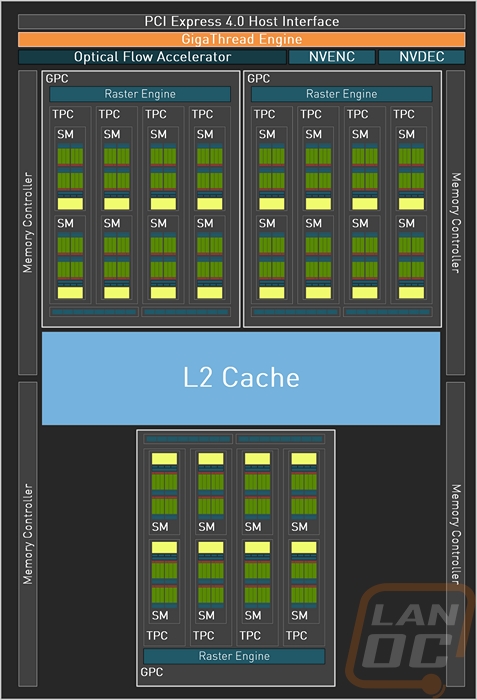
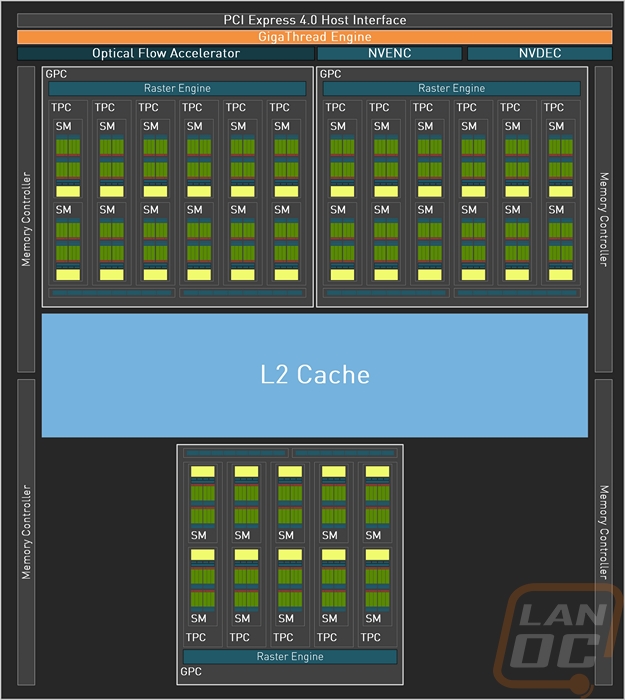
|
Specifications |
|
|
Graphics Processing Clusters |
3 |
|
Texture Processing Clusters |
12 |
|
Streaming Multiprocessors |
24 |
|
CUDA Cores (single precision) |
3072 |
|
Shader FLOPS |
15 |
|
Tensor Cores |
96 (4th Generation) |
|
Tensor FP8/INT8 TFLOPS/TOPS w/ Sparsity |
242 |
|
RT Cores |
24 (3rd Generation) |
|
RT FLOPS |
35 |
|
Texture Units |
96 |
|
ROP Units |
48 |
|
Base Clock |
1830 MHz |
|
Boost Clock |
2460 MHz |
|
Memory Clock |
8500 MHz |
|
Memory Data Rate |
17 Gbps |
|
L1 Data Cache/Shared Memory |
3072 K |
|
L2 Cache Size |
24576 K |
|
Total Video Memory |
8 GB GDDR6 |
|
Memory Interface |
128-bit |
|
Total Memory Bandwidth |
272 GB/s (453 GB/sec effective)* |
|
Texture Rate (Bilinear) |
236 GigaTexels/second |
|
Max Display Resolution |
4K at 240Hz or 8K at 60Hz with DSC |
|
Fabrication Process |
4N NVIDIA Custom Process |
|
Transistor Count |
18.9 Billion |
|
Connectors |
3 x DisplayPort 1 x HDMI |
|
Form Factor |
Dual-Slot |
|
Power Connectors |
2x PCIe 8-pin cables (adapter in box) OR 300 W or greater PCIe Gen 5 cable |
|
Required System Power Supply |
550 Watts |
|
Video Engines |
1xNVENC (8th Gen) 1xNVDEC (5th Gen) |
|
Power |
7W Idle, 11W AV1 Video Playback, 110W Average Gaming Power (AGP), 115 W Total Graphics Power (TGP) |
|
Max GPU Temperature |
90° C |
Nvidia’s presentation on the RTX 4060 was of course focused on how the RTX 4060 compares to previous generation cards, not the RTX 4060 Ti and they did put together a nice table showing how the RTX 4060 compares to past xx60 cards from the RTX 3060, to the RTX 2060, and the GTX 1060. It does a good job showing how shader performance has increased over the years from 4 TFLOPS on the 1060 up to 15 TFLOPS for the RTX 4060. It does also show the generation-to-generation increase from the 3060 to the 4060 isn’t as large, at least on shader performance. The ray tracing and tensor core performance on the other hand has much more significant improvements especially the tensor cores which went from 102 TFLOPS to 242 TFLOPS which is interesting because the RTX 3060 had 112 3rd generation tensor cores whereas the RTX 4060 has fewer at 96 but the new 4th generation design does the work to get more than double the performance with a 137% improvement. The 12GB frame buffer on the 3060 is back down to 8GB which is higher than the 2060 and 1060 which both had 6GB. Nvidia is quick to point out that they are able to utilize a much larger L2 cache to use less frame buffer which is why the memory subsystem has the 272 GB/s and 453 GB/s numbers for memory performance. The power numbers are interesting as well with the RTX 4060 being much more power efficient compared to all but the GTX 1060 which was lower in everything except TGP.
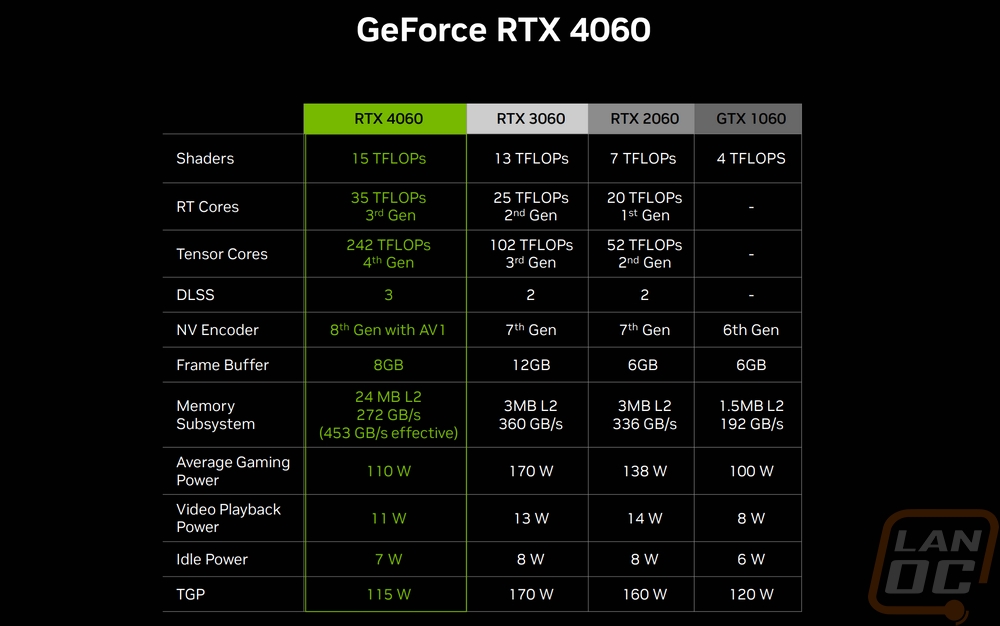
Speaking of power, this part of the presentation was interesting. They broke down what an average of 10-20 hours of gaming a week can cost for power depending on where you are around the world and what the power savings just between the RTX 3060 and the RTX 4060 could get you. The actual power costs are going to vary a LOT depending on where you are even just in the US alone. I know for myself that in my own house in rural Ohio our actual rate per kWh after all fees is lower at .13 a kWh before this year and up to .20 on our last bill. For someone with rates like mine, the power difference might not make a difference, but anywhere it is higher it could start to play a bigger role in your decision.
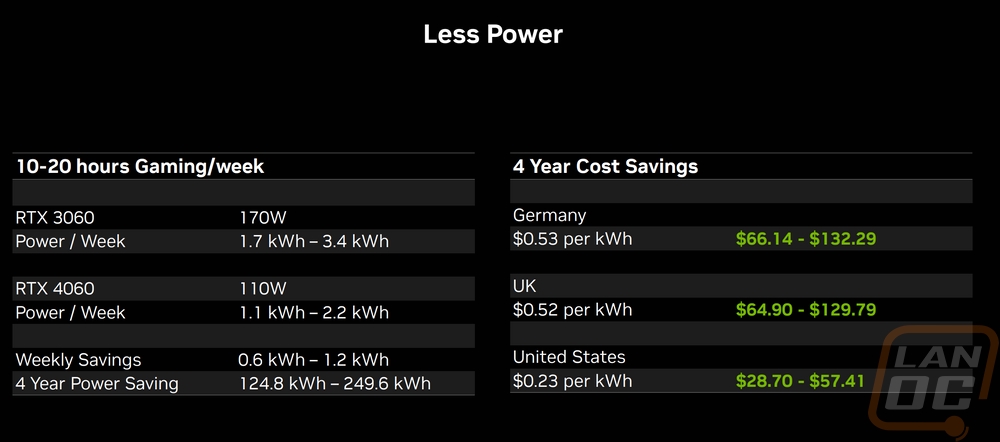
I mentioned it in the opening here and also with the RTX 4060 Ti, the most popular cards on the current Steam Hardware Survey are the xx60 and cards and a lot of those cards are getting a little long in the tooth. Depending on the person some people look at upgrades every few generations and others just use them until they run into performance issues. Both types of gamers were affected by the low availability and high prices caused by the combination of Covid and another mining craze and you can see it on the hardware charts. The GTX 1060 is still the second most popular card on the platform and it launched 7 years ago this July, the 1050 Ti which is also on there was around that time as well. Even the GTX 1660 and the RTX 2060 which are just two generations back officially are 4 years old as well. That is a lot of people who might be considering an upgrade.
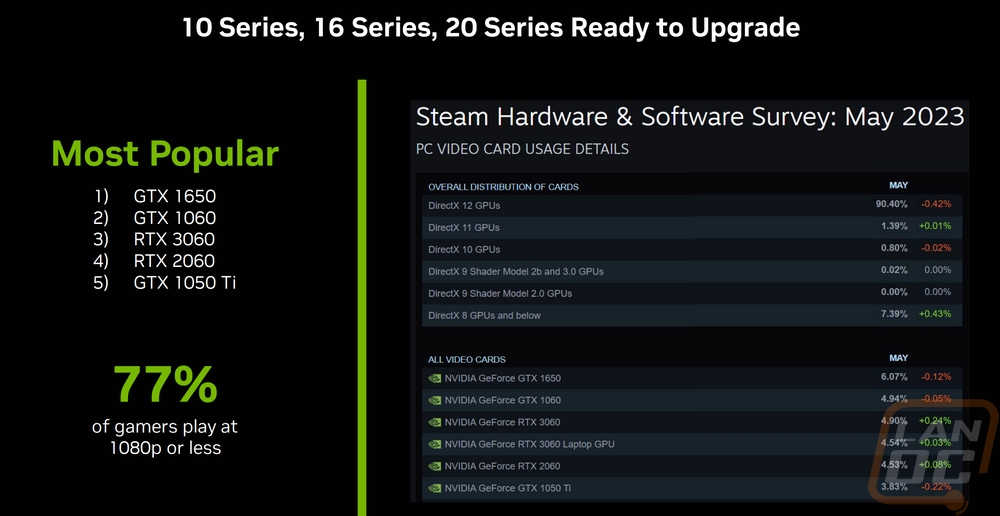
Before getting into testing I did also run GPUz to double-check that our clock speeds match up with the specifications. The RTX 4060 Twin Edge OC has the same base clock and memory clock as Nvidia’s recommended specifications. Their overclock is focused on the boost clock with it set to 2490 MHz which is 30 MHz over the stock clock. GPUz also documents the BIOS revision we tested with as well as the driver which is NVidia’s 536.20 beta driver that was provided to press ahead of the launch.

|
RTX 4060 Twin Edge OC White Edition Specifications |
|
|
SKU |
ZT-D40600Q-10M |
|
Colors Available |
Black and White models |
|
CUDA cores |
3072 |
|
Video Memory |
8GB GDDR6 |
|
Memory Bus |
128-bit |
|
Engine Clock |
Boost- 2490 MHz |
|
Memory Clock |
17 Gbps |
|
PCI Express |
PCIe 4.0 x8 |
|
Display Outputs |
3 x DisplayPort 1.4a |
|
HDCP Support |
Yes, 2.3 |
|
Multi Display Compatibility |
Quad Display |
|
Recommended Power Supply |
500W |
|
Power Consumption |
115W |
|
Power Input |
1x 8-pin |
|
Power Phase |
4+1 |
|
Cooling |
1x6mm heatpipe (silver color) |
|
Slot Size |
2-Slot |
|
Card Lenth |
221.4 mm x 122.7 mm x 43.1 mm |
|
Card Weight |
0.55kg / 1.21lbs |
|
Accessories |
Manual |
|
Features |
White LED Logo lighting, not adjustable |
|
Warranty |
3-Years |


